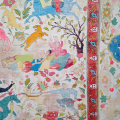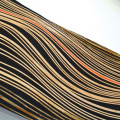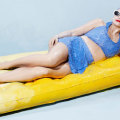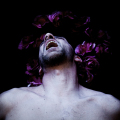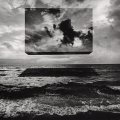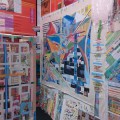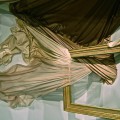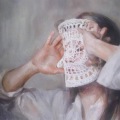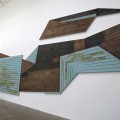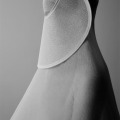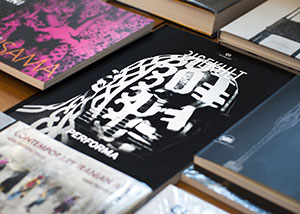Los Angeles native and New York based visual artist, Kehinde Wiley has firmly situated himself within art history’s portrait painting tradition. As a contemporary descendent of a long line of portraitists, including Reynolds, Gainsborough, Titian, Ingres, among others, Wiley, engages the signs and visual rhetoric of the heroic, powerful, majestic and the sublime in his representation of urban, black and brown men found throughout the world. What first got you interested in painting? I began with studying art back in LA as a young kid. I first went to art school when I was about 11 and went to big museums in Southern California. I grew up in South Central Los Angeles in the late 80’s and was very much a part of the environment that was driven by some of the defining elements of hip-hop: the violence, anti-social behavior, streets on fire. I was fortunate because my mother was very much focused on getting me, my twin brother, and other siblings out of the hood. On weekends I would go to art classes at a conservatory. After school, we were on lockdown. It was something I hated, obviously, but in the end it was a lifesaver. In art school, I just liked being able to make stuff look like other stuff. It made me feel important. Back then, it was basic apples and fruit and understanding light and shadow. From there I did the body and a lot of self-portraiture. So much of what I do now is a type of self-portraiture. As an undergrad at the Art Institute of San Francisco, I really honed in on the technical aspects of painting and being a masterful painter. And then at Yale it became much more about arguments surrounding identity, gender and sexuality, painting as a political act, questions of post-modernity, etc. How do you select countries to be a part of The World Stage? The World Stage is comprised of what I believe are countries on the conversation block in the 21st century. Many of the reasons why I choose certain sites have to do with a level of curiosity, but it also has to do with their broader, global, political importance- strategically for America, and the world community at large. One of the reasons I chose Brazil, Nigeria, India and China is that these are all the points of anxiety and curiosity and production that are going on in the world that are changing the way we see empire. As I’ve been traveling, I started to notice that the way many people in other parts of the world interact with American culture is through black American expression. It’s an interesting phenomenon. And increasingly, I want to engage with that question. If I am finding completely unknown guys on the streets of America, what does that look like when it happens in West Africa, in India? And when I started to do that, I had to ask myself some questions. Am I going to base this project on Western painting? Increasingly the answer was no because there was a wealth of history in each of these countries. Outside of The World Stage, why do you mainly paint African Americans? I loved when I walked into LACMA as a kid and seeing Kerry James Marshall’s grand barbershop painting. But it was thrown into very sharp relief when thinking about the absence of other black images in that museum. There was something absolutely heroic and fascinating about being able to feel a certain relationship to the institution and the fact that these people happen to look like me on some level. One of the reasons I’ve chosen some of these zones had to do with the way you fantasize, whether it be about your own people or far-flung places, and how there’s the imagined personality and look and feel of a society, and then there’s the actuality that sometimes is jarring, as a working artist and traveling from time to time. Being in southern India, that black American hip hop culture is everywhere and to see it in sharp relief on these brown bodies in south Asia is something extraordinary, something that I wanted to get down without even fully understanding the entirety of the cultural context. I think it’s important to destabilize yourself, and I do it because I want to see people who look like me. How do you find your models? I cast all my models on the streets of New York, and in the case of The World Stage, on the streets of that respective country. I have a camera crew with me, examples of my work and usually an attractive woman with me because there’s something homoerotically charged about this whole interaction. Me as a male talking to another male, and predisposing that there’s some kind of beauty being exchanged or desired. Usually on the American street there’s this kind of celebrity culture where people aren’t shocked, but they’ve been found. “Of course you discovered me, it’s about time”. Whereas in places like Nigeria or Brazil, even Sri Lanka, people didn’t know what was going on. It took a lot more explanation, and they would still say, “Well, why me?” In America, it’s, “Of course me”. When street casting, I would say I look for alpha male behavior and sensibility, but what that ultimately ends up looking like can be sometimes conflicting. Sometimes someone who is very large in presence and gait is in the same photo shoot as someone rather small. I don’t think I have a formula for it, but it’s sort of in the process that it all comes out. What typically inspires a painting? Classical European paintings of noblemen, royalty and aristocrats. My goal was to be able to paint illusionistically and master the technical aspects, but then to be able to fertilize that with great ideas. I was trained to paint the body by copying the Old Master paintings, so in some weird way this is a return to how I earned my chops — spending a lot of time at museums and staring at white flesh. If you look at my paintings, there’s something about lips, eyes, and mucous membranes. Is it only about that? No. It asks, “What are these guys doing?’ They’re assuming the poses of colonial masters, the former bosses of the Old World. Whenever I do photo shoots for paintings, I pull out a stack of books, whether it be something from the High Renaissance or the late French Rococo or the 19th century, it’s all thrown together in one big jumble. I take the figure out of its original environment and place it in something completely made up. Most of the backgrounds I end up using are sheer decorative devices. Things that come from things like wallpaper or the architectural façade ornamentation of a building, and in a way it robs the painting of any sense of place or location, and it’s located strictly in an area of the decorative. For the backgrounds in the World Stage Series, I look for traditional decorative objects, textiles, or devotional objects of that culture to draw upon. Why the shift to painting women in your An Economy of Grace series? The reason why I am painting women now is in order to come to terms with depictions of gender and the way it is featured art historically–a means to broaden the conversation. Any consideration of male power in painting naturally includes the presence of women within that dialogue. “An Economy of Grace” is an investigation of the presence of women in painting, but in a broader sense, it is a investigation of the negotiation of power in image-making. For this body of work I looked to 18th and 19th-century society portraits for inspiration. At that time it was common practice for nobility to commission unique clothing for portraiture. By working with a major fashion house on this project (Givenchy), we’re revamping that tradition for the 21st century. I’ve always been a big fan of Givenchy and Riccardo Tisci’s work, so it was a wonderful opportunity to work with him.


























